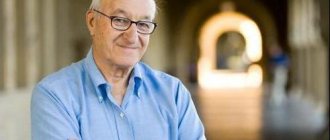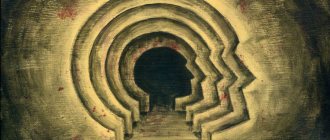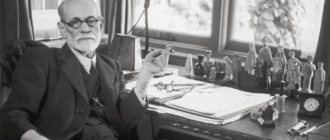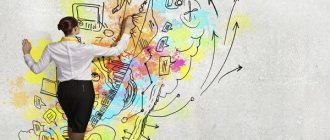Introduction
At the turn of the 19th and 20th centuries in psychology, at that time still a very young scientific discipline, a bright and significant direction arose that continues to exist and develop to this day - psychoanalysis. The founder of psychoanalysis was the brilliant scientist, Austrian neurologist and psychiatrist Sigmund Freud (1856-1939). The fundamental difference between S. Freud’s theory and other areas of psychology of that time was the use of such an approach to the subject of science, in which the most important structural component of the psyche was its unconscious component (the unconscious, or “Id”). In other areas of psychology, the unconscious sphere of personality was not given much importance, or its existence was completely ignored.
S. Freud's psychoanalytic theory, striking in its depth, had a highly significant impact on the scientific community contemporary to its author and even on some aspects of the development of civilization, especially on art. Many followers of S. Freud appeared - adherents of the theory of psychoanalysis.
However, some students of the founder of this theory did not share his views in everything. The most talented of them include the Austrian ophthalmologist and psychiatrist Alfred Adler (1870-1937) and the Swiss psychiatrist Carl Gustav Jung (1875-1961). Inspired by the theory of S. Freud, these scientists, based on it, created their own directions of psychoanalysis: A. Adler called his theory individual psychology, C. G. Jung - analytical psychology.
Due to the fact that K. G. Jung was a highly educated person and had extensive knowledge in various fields of scientific knowledge [2, p. 59], the origins of analytical psychology lie not only in the psychoanalytic theory of S. Freud, but also in philosophy, mythology, and cultural studies and many others
This work is devoted to the study of analytical psychology by C. G. Jung.
Personality structure in the theory of C. G. Jung
Like S. Freud, C. G. Jung distinguished conscious and unconscious spheres in the structure of a person’s personality (soul). From the point of view of C. G. Jung, these spheres are essentially opposite to each other: “the unconscious, as Jung believes, is like the reflection of a mountain in a lake, a mirror image, the other side of the conscious... the unconscious is seen as performing a compensatory function” [2, p. 66 ].
The conscious sphere, according to C. G. Jung, includes conscious thoughts, feelings, memories and sensations and serves as the basis of self-awareness, allowing a person to perceive himself as a holistic and permanent personality [6, p. 200].
In the structure of the unconscious sphere of personality, C. G. Jung identified two separate but interacting components: the personal unconscious and the collective unconscious. The personal unconscious is a more superficial layer of the unconscious, the content of which is sensory complexes - “accumulations of emotionally charged thoughts, feelings and memories brought by the individual from his past personal experience” [6, p. 200]. Complexes, as a rule, are formed as a result of the influence of the repression mechanism - forgetting traumatic information.
The collective unconscious, from the point of view of C. G. Jung, is a deeper layer of the unconscious sphere of the individual, “which does not represent personal experience and is not acquired during life, but is innate” [7, p. 172]. The collective unconscious is genetically embedded in every person and “owes its existence exclusively to heredity” [1, p. 71].
The content of the collective unconscious is represented by archetypes. Archetypes are images of human memory, essentially similar to attitudes: they determine a person’s predisposition to certain reactions in certain conditions. At the same time, the archetype “begins to function everywhere where either conscious concepts do not yet exist, or where such, for internal or external reasons, are generally impossible” [9, p. 459], i.e. in cases where a person does not have the opportunity to focus on his own individual experience.
Thus, C. G. Jung’s point of view on the subject of personality structure can be presented in the form of the following diagram:
If C. G. Jung’s ideas about the conscious sphere of the individual and the personal unconscious largely coincide with the content of the theories of S. Freud and other supporters of psychoanalysis, then the concept of the collective unconscious is a feature of analytical psychology.
C. G. Jung came to the conclusion about the existence of archetypes based on an analysis of significant similarities between the images he repeatedly observed in the descriptions of fantasies, dreams, delusions and obsessions of his patients, with images contained in myths and fairy tales of many cultures. C. G. Jung believed that such similarities are due to their common nature: “the reduced activity of consciousness and lack of concentration of attention, abaissement du niveau mental [1], correspond quite accurately to the primitive state of consciousness in which, presumably, myths were originally formed. Therefore, it seems extremely likely to us that mythological archetypes arose in much the same way as today’s manifestations of archetypal structures in individuals” [8, p. 91].
The functional meaning of archetypes, according to K. G. Jung, lies, on the one hand, in the transmission of significant information about environmental objects and their properties from generation to generation and, thus, contributes to the adaptation of individuals to environmental conditions. On the other hand, archetypes can serve as psychological protection: “religious myths can be interpreted as a kind of mental therapy against the suffering and unrest of all humanity - hunger, wars, disease, old age, death. The world-wide myth about the hero, for example, always describes a powerful man or god-man who defeats evil in all its manifestations in the form of dragons, snakes, monsters, demons, etc., and saves people from destruction and death" [11, p. 88 -89].
The main examples of archetypes described by C. G. Jung are [6, p. 201]:
- Anima is the unconscious feminine side of a man’s personality;
- Animus is the unconscious male side of a woman’s personality;
- God is the ultimate realization of psychic reality, projected onto the external world;
- The sage is the personification of life’s wisdom and maturity;
- Persona is a “public face”, a person’s social role that stems from social expectations and early learning;
- The Self is the embodiment of the integrity and harmony of the individual;
- The shadow is the socially unacceptable unconscious opposite of what the individual persistently affirms in consciousness.
Thus, the most important scientific discovery of C. G. Jung in the field of studying the psychological structure of personality is the idea of the existence of a collective unconscious common to all people - a repository of the memory of humanity, and archetypes - images that make up its content.
Analytical psychology is primarily therapy
Jung was a practicing psychotherapist, so all his discoveries were created by him on theoretical conclusions and practical application.
Jung devoted his entire life to creating a method of working with the unconscious. He believed that positive results can only be achieved with complete trust between the patient and the doctor. Therefore, he practiced conversations, encouraged any kind of creativity, helped the patient build new, more comfortable relationships with others, projecting them onto the doctor.
To understand the unconscious, Jung used the following methods:
- Association test
. In the process, stimulus words are identified that cause painful heightened feelings. You can find out what worries a person at the subconscious level by re-reading the associative series and putting the words together. - Dream analysis
. Jung paid special attention to this method. He considered dreams to be a manifestation of the position of a self-regulating mental system. This unconscious warns a person about imbalance. To interpret dreams, Jung used the amplification method (searching for parallels with well-known motifs in art, culture, literature, religion). - Active imagination
. Jung considered creativity to be one of the most effective therapies.
For reference:
According to the psychotherapist, working with directions should harmonize the relationship between the conscious and unconscious in a person.
Personality typology K.G. cabin boy
Another important discovery of C. G. Jung in the field of personality psychology is the classification he developed of the so-called ego-orientation and description of the characteristics of extroverted and introverted personality types.
C. G. Jung came to the idea of the existence of two fundamentally different personality types based on an analysis of his own twenty years of experience working with patients. He noticed that the functioning of the mental sphere of some people is focused primarily on the object - external conditions, while the source of the mental activity of other people is the subject - internal factors.
C. G. Jung called the phenomenon of mental activity turning to the external environment extraversion: “if orientation by the object and by the objectively given predominates so much that most often the most important decisions and actions are determined not by subjective views, but by objective circumstances, then we are talking about an extroverted attitude ... If a person thinks, feels and acts, in a word, lives in a way that directly corresponds to objective conditions and their requirements, both in a good and in a bad sense, then he is extroverted. He lives in such a way that the object, as a determining quantity, obviously plays a more important role in his consciousness than his subjective view... His entire consciousness looks into the external world, for an important and determining decision always comes to him from the outside” [9, p. 406-407].
The opposite phenomenon - the reversal of mental activity on the inner world of a person - was given the name introversion by C. G. Jung: “the introverted type differs from the extroverted one in that it is focused primarily not on the object and not on objective data, like the extroverted one, but on subjective factors... introverted consciousness sees external conditions and nevertheless chooses the subjective determinant as decisive” [9, p. 455].
Analyzing the functional meaning of extraversion and introversion, C. G. Jung drew an analogy between the psychological characteristics of these types and the characteristics of two types of biological adaptation of the human body to the environment. “Nature knows two fundamentally different adaptation options and two, resulting from them, possibilities for self-sustainment of living organisms,” writes K. G. Jung, “the first path is increased fertility with relatively low defense capacity and fragility of the individual; the second way is to equip the individual with various means of self-preservation with relatively low fertility. It seems to me that this biological opposition is not only an analogy, but also the common basis of our two psychological modes of adaptation. Here I would like to limit myself to just one general indication, on the one hand, of the peculiarity of the extrovert, which consists in the ability to constantly waste, spread and penetrate into everything; on the other hand, the introvert’s tendency to defend himself from external demands and, as far as possible, to refrain from any expenditure of energy directed directly at the object, but to create for himself the most secure and powerful position possible” [9, p. 404].
The author of these concepts believed that each person simultaneously has both mechanisms, extraversion and introversion, and belonging to a certain personality type is determined only by the predominance of one or the other.
In developing a personality typology, C. G. Jung did not limit himself to classifying people according to their ego orientation. Also based on his own many years of experience, he discovered that “Consciousness orients itself in the environment in the following four functional ways: through sensation (that is, perception by the senses), indicating the presence of something; reflection explaining to us what it is; a feeling that tells us whether it is pleasant or not, and an intuition that tells us where it comes from and where it is going” [11, p. 56]. Sensation, thinking, feeling and intuition were called mental functions by C. G. Jung. All these functions are present in every person, but one of them, as a rule, dominates over the others. Therefore, both extroverted and introverted personality types, depending on the predominance of the value of one or another mental function, can also be thinking, feeling, sensing or intuitive.
Developing the theory of mental functions, C. G. Jung classified thinking and feeling as rational functions, sensation and intuition as irrational. The difference between rational and irrational functions is that if the former “base their entire course of action on the judgment of the mind,” then the latter “on the absolute power of perception” [9, p. 452].
Thus, C. G. Jung’s personality typology is built on two bases: the predominant ego orientation (extroversion or introversion) and the leading mental function (thinking, feeling, sensing or intuition). The interaction of both forms the eight main types of human personality: extroverted thinking, extroverted feeling, extroverted feeling, extraverted intuitive, introverted thinking, introverted feeling, introverted feeling and introverted thinking.
Representations by K.G. Jung on personality development
C. G. Jung attached great importance to issues of personality development in his theory. The peculiarities of his views on personality development are associated with the concepts of “self” and “individuation”.
As already mentioned (see point 1), the self is the archetype of mental integrity and unity of personality. However, the self acts not only as an archetype, but also as the ultimate goal of personality development. The archetypal features of selfhood are associated with the fact that, firstly, its final achievement is empirically impossible (hence, the development of personality essentially has no limit), and secondly, the desire for intrapersonal harmony is characteristic of almost all people without exception, which determined the consolidation of selfhood as one of the leading symbols in the collective unconscious. The very concept of “personality” in connection with the achievement of selfhood was defined by C. G. Jung as “a definite, capable of resistance and endowed with strength mental integrity” [10, p. 68].
K. G. Jung understood individual and social as phenomena interconnected by inverse proportionality: the more social, the less individual, and vice versa. Therefore, the achievement of selfhood, according to C. G. Jung, can only be achieved through individuation - to the detriment of the social. Individuation is a process of differentiation, separation of the individual from the social and “formation... of the psychological individual as a being different from the general, collective psychology” [9, p. 536]. The ultimate goal of individuation is also the development of personality. In connection with the implementation of the process of individuation, C. G. Jung also defined the concept of “personality” as “the highest realization of the innate originality of an individual living being” [10, p. 70].
At the same time, individuation does not necessarily mean that the individual comes into conflict with social norms: “Individuation under no circumstances can be the only goal of psychological education. Before making a goal out of individuation, it is necessary to achieve another goal of education, namely, adaptation to the minimum of collective norms necessary for existence: a plant intended for the fullest development of its abilities must first of all be able to grow in the soil in which it is planted "[9, p. 538].
Since personality development is associated with individuation, it inevitably requires significant psychological effort and expense: “personal development from initial inclinations to full consciousness is charisma and at the same time a curse: the first consequence of this development is the conscious and inevitable isolation of an individual being from the indistinguishability and unconsciousness of the herd. This is loneliness, and nothing comforting can be said about this. No successful adaptation and no unhindered adaptation to the existing environment, nor family, society, or position will get rid of this” [10, p. 72].
The presence of a large number of difficulties encountered on the path of personality development leads to the fact that not every person becomes an individual: “The fact that conventions of some kind invariably flourish proves that the overwhelming majority of people choose not their own path, but the conventions and as a result, each of them develops not himself, but some method, and therefore something collective at the expense of his own integrity” [10, p. 73].
Personal development, according to C. G. Jung, can continue throughout a person’s life.
Thus, the development of personality, from the point of view of C. G. Jung, is carried out in the direction of achieving selfhood (personal integrity and harmony) through individuation (separation of the individual from society).
Some possible examples
Examples of the collective unconscious in reality can be identified during the analysis of the behavior of a person who is in a crowd. Here it manifests itself through the following behavioral types (speaking in scientific terms):
- unifying mass behavior during strikes and various protests - a single charged emotional background;
- behavior that separates the masses - the type where there is panic and chaos;
- the emotional shock of people and the mechanisms of behavior in an extraordinary situation begin to work with the developed survival instinct.
The main differences between the personality theories of S. Freud and C. G. Jung
As already noted (see Introduction), C. G. Jung’s analytical psychology arose primarily on the basis of the psychoanalytic theory of S. Freud, but is a separate direction due to the presence of some significant differences from psychoanalysis. It is known that S. Freud and C. G. Jung “worked in close collaboration for many years. As Freud believed, Jung was to become his successor and serve in the Vienna Psychoanalytic Society" [4, p. 189]. However, in 1913, there was a break in relations between them, “due to which Freud, as is well known, lost consciousness twice” [4, p. 189], and C. G. Jung experienced a severe mental crisis for four years [6 , page 198]. Nevertheless, “their names were so closely connected that when Jung, when asked by the curator of the British Museum to name his last name, said “Jung,” he asked again: “Freud-Jung-Adler?” and heard an apology in response: “No, only Jung” [5, p. 157].
In this regard, it is advisable to analyze the differences between the personality theories of S. Freud and C. G. Jung. The most common point of view regarding the source of the differences in the views of S. Freud and C. G. Jung is the assumption that C. G. Jung did not share the so-called increased attention of S. Freud to sexuality [6, pp. 197-198]. However, upon careful examination of at least the correspondence between S. Freud and C. G. Jung, it turns out that this point of view is apparently due to a misunderstanding of the essence of S. Freud’s theory. Thus, in one of his letters to S. Freud, C. G. Jung writes: “the expression “libido”, in general all terms transferred from sexuality to a sphere that is too broadly understood by you (which, no doubt, has its justification), allow for false interpretations and, at the very least, unsuitable from a didactic point of view. They immediately cause a defensive emotional reaction, which leads to discrediting the entire therapy” [From Jung’s letter to Freud dated March 31, 1907; 3, p. 374]. In turn, S. Freud repeatedly mentions his discussions with opponents of such terminology: “they attacked me, demanding that I replace the concept of “sexuality” with another word ... then all objections and misunderstandings will disappear by themselves. I replied that I did not believe in the success of such an enterprise; by the way, they were never able to offer me another term” [From Freud’s letter to Jung dated 10/15/1908; 3, p. 396]. Thus, the opinion that S. Freud exaggerated the importance of sexuality was apparently caused only by shortcomings in terminology, which led to difficulties in understanding psychoanalysis.
As evidenced by the analysis of the correspondence, S. Freud treated the alternative concepts of his followers quite adequately. For example, his reaction to one of the theoretical disagreements with C. G. Jung were the following lines: “The nature of your innovation is not very clear to me yet... As soon as I have enough information, I will certainly be able to understand everything objectively, if only because I am aware of my bias” [From Freud’s letter to Jung dated June 13, 1912; 3, p.450]. Apparently, the break in the relationship between S. Freud and C. G. Jung was largely due to personal factors. Thus, in one of his last letters, K. G. Jung openly stated: “I want to draw your attention to the fact that your technique of dealing with your students is erroneous... You reduce your surroundings to the level of sons and daughters who, blushing, confess to you having vicious tendencies. And every time you proudly rise above them in the role of a father” [From Jung’s letter to Freud dated 12/18/1912; 3, pp.461-462].
Returning to the differences between the personality theories of S. Freud and C. G. Jung, the following main aspects should be noted:
- Personality structure. The concept of “personal unconscious” in the analytical psychology of C. G. Jung is generally similar to the concept of “Id” in the psychoanalysis of S. Freud; There are also no significant differences in the understanding of the conscious sphere of personality between these theories. The difference in the ideas of both authors about the structure of personality lies in the fact that if Z. Freud identified the “Super-Ego” as the third component of personality, then C. G. Jung identified the “collective unconscious.” The super-ego in psychoanalysis is the result of the assimilation in childhood of social norms and rules of behavior, i.e. a system of moral prohibitions and ideals acquired in the process of socialization (mainly education). The similarities between the Super-Ego and the collective unconscious, first of all, include their social basis, the differences include the acquired character of the Super-Ego and the innate character of the collective unconscious.
- Typology and personality development. According to the psychoanalytic theory of S. Freud, a person’s personality in childhood in its development, based on the dynamics of the dominance of erogenous zones, goes through several stages (oral, anal, phallic, latent and genital). In cases where at any stage the child receives excessive or insufficient stimulation of the dominant erogenous zone, one or another type of personality is formed; a mature personality is formed only if it adequately goes through all stages. At the same time, the foundation of personality is laid by the age of 5-6 years. Thus, S. Freud emphasized the biological aspect of personality development, which, in turn, is the basis for personality typology. K. G. Jung, as already noted (see paragraphs 2 and 3), in the problem of personality typology, focused on ego-orientation and mental functions, and in the problem of personality development - mainly on the individual aspect and on the relationship between the individual and the social. Therefore, the ideas of S. Freud and C. G. Jung on the subject of typology and personality development essentially do not coincide, but they do not intersect, and therefore are not mutually exclusive.
Thus, the main differences between the theories of S. Freud and C. G. Jung come down, firstly, to the differences between the “Super-Ego” in psychoanalysis and the “collective unconscious” in analytical psychology, and secondly, to the presentation of C.G. Jung on the continuation of personality development throughout life, as opposed to S. Freud’s idea that the fundamental component of personality is laid down in early childhood.
Basic provisions
Jung introduced new concepts into terminology that define the profound influence on the formation and formation of a person’s personality.
In a psychiatric clinic, under his supervision there were several dozen people with various mental disorders. Working with patients, Jung came to the conclusion that the integrity of the human psyche is not determined only by his consciousness.
There are systems that form the structure of personality under the influence of external and internal factors. These systems formed the basis of his teaching.
Bibliography
- Analytical psychology: Past and present / K. G. Jung, E. Samuels, V Odaynik, J. Hubback; Comp. V.V.Zelensky, A.M.Rutkevich. – M.: “Martis”, 1995. – 320 p. – (Series “Classics of Foreign Psychology”).
- Brown J. Freudian psychology and post-Freudians. – M.: “Refl-book”, 1997. – 298 p. – (Series “Current Psychology”).
- Sigmund Freud – Carl Gustav Jung. From correspondence / Freud Z. Beyond the pleasure principle. M.: “Litera”, 1992. – p. 364-467.
- Kutter P. Modern psychoanalysis. Introduction to the psychology of unconscious processes. – St. Petersburg: “B.S.K.”, 1997. – 324 p.
- Petrovsky A.V., Yaroshevsky M.G. History and theory of psychology. - In 2 volumes. – Volume 1. – Rostov-on-Don: “Phoenix”, 1996. – 416 p.
- Kjell L., Ziegler D. Theories of personality. – 3rd ed. – St. Petersburg: Peter, 2005. – 607 p. – (Series “Masters of Psychology”).
- Jung K.G. Alchemy of dreams. Four archetypes. – M.: “Semira”, 1995. – 350 p.
- Jung K.G. Soul and myth. Six archetypes. – Kyiv: “State Library of Ukraine for Youth”, 1996. – 384 p.
- Jung K.G. Psychological types. – M.: “AST”, 1998. – 720 p. – (University Book Series).
- Jung K.G. Formation of personality / Psychology of personality in the works of foreign psychologists / Comp. and general editing by A.A. Reana - St. Petersburg: Peter Publishing House, 2000. - p. 65-79. – (Series “Anthology on Psychology”).
- Jung K.G. Man and his symbols. – St. Petersburg: “B.S.K.”, 1996. – 454 p.
[1] Decrease in mental level (lat.)









